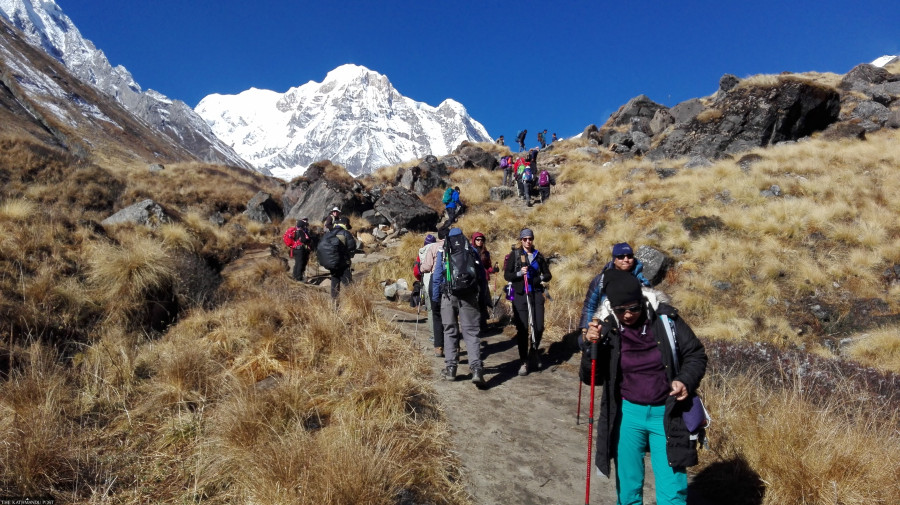Money
Growth in services sector expected to drive Nepal’s recovery
South Asia has an opportunity to shift gears from a traditional manufacturing-led growth model and capitalise on the potential of its services sector, World Bank report says.
Post Report
A gradual recovery is underway in Nepal, boosted by the lifting of containment measures as vaccination picks up, and tourism and migrant worker flows recover, the World Bank said on Thursday, predicting that Nepal’s economy may grow by 3.9 percent in the current fiscal year ending mid-July 2022.
According to the World Bank’s South Asia Economic Focus released on Thursday, Nepal could have grown by 1.8 percent in the last fiscal year, but the growth rate is still below pre-pandemic growth averages.
Recovery continues in South Asia as global demand rebounds and targeted containment measures help minimise the economic impacts of the recent waves of Covid-19. But the recovery remains fragile and uneven, and most countries are far from pre-pandemic trend levels, states the World Bank’s twice-yearly regional update.
In Nepal, recovery is vulnerable to risks and will rely on the continued gradual resumption of economic activities alongside social distancing and an effective vaccination rollout this year.
After the second Covid-19 wave hit Nepal in April, the country slid into a devastating crisis with the authorities enforcing strict lockdown measures. About two months later, the restrictions were relaxed gradually; and since September 1, almost everything has been allowed to reopen.
Daily coronavirus infections have also fallen sharply from a high of 9,317 on May 11, 2021 to 805 on Thursday.
Restrictions on businesses have been eased, and encouraging signs of an economic revival are emerging even as concerns persist about renewed outbreaks.
On September 23, Nepal dumped the seven-day quarantine requirement and resumed issuing on-arrival visas to all vaccinated foreign travellers in a bid to bring its virus-ravaged tourism industry back to life.
Travel and tourism businesses, which accounted for around 8 percent of the country's gross domestic product and provided more than 1.05 million jobs directly and indirectly in pre-Covid days, were the hardest hit after travel restrictions came into force in late March last year.
The Ministry of Health and Population said that it aims to administer Covid-19 vaccines to at least 33 percent of the population by the Dashain festival which is a week away.
As of Thursday, 8 million people (over 26.66 percent) had taken the first dose of the vaccine and 6.43 million people (over 21.43 percent) had been fully vaccinated.
The latest South Asia Economic Focus entitled "Shifting Gears: Digitisation and Services-Led Development" expects the region to grow by 7.1 percent in 2021 and 2022. While year-on-year growth remains strong in the region, albeit from a very low base in 2020, the recovery has been uneven across countries and sectors.
South Asia’s average annual growth is forecast to be 3.4 percent over 2020-23, which is 3 percentage points less than it was in the four years preceding the pandemic.
“The pandemic provides the opportunity for countries to craft a recovery path that draws lessons from the crisis,” stated Faris Hadad-Zervos, World Bank country director for Maldives, Nepal, and Sri Lanka.
“Nepal recently adopted the Kathmandu Declaration as a joint commitment of the government and development partners towards the country’s Green, Resilient and Inclusive Development (GRID). Mobilising the private sector through green investment and support for small and medium enterprises with job growth potential in the services sector is a key part of Nepal’s GRID strategy.”
Covid-19 has left long-term scars on the region’s economy, the impacts of which can last well into the recovery. Many countries experienced lower investment flows, disruptions in supply chains and setbacks to human capital accumulation, as well as substantial increases in debt levels. The pandemic is estimated to have caused 48 to 59 million people to become or remain poor in 2021 in South Asia.
As countries build back, they have a chance to rethink their long-term development models. With the emergence of new digital technologies, South Asia has an opportunity to shift gears from a traditional manufacturing-led growth model and capitalise on the potential of its services sector.
The role of services in the region’s economy has been increasing amid rapid technological change, and the accelerated structural transformation of global economic activity in response to the pandemic. The adoption of digital technologies makes services more tradable, enables services to increase the productivity of other sectors—including manufacturing—and creates new markets.
Some South Asian countries are increasingly providing business and professional services that add value to manufacturing, and play a key role in global value chains.
In Nepal, the pandemic has accelerated the growth of digital services, with the use of electronic payment transactions increasing by double digits. Growth in the services sector as a whole is expected to drive Nepal’s recovery, despite structural constraints such as slow domestic job creation, the country’s high vulnerability to natural disasters and climate change, and large infrastructure gaps.
“Countries in South Asia have a strong comparative advantage in exporting services, particularly business processes and tourism, whereas they have struggled to break into manufacturing export markets,” said Hans Timmer, World Bank chief economist for the South Asia Region. “To realise the potential of the services-led development, the region needs to rethink regulations and establish new institutions to support innovation and competitiveness.”




 15.12°C Kathmandu
15.12°C Kathmandu














